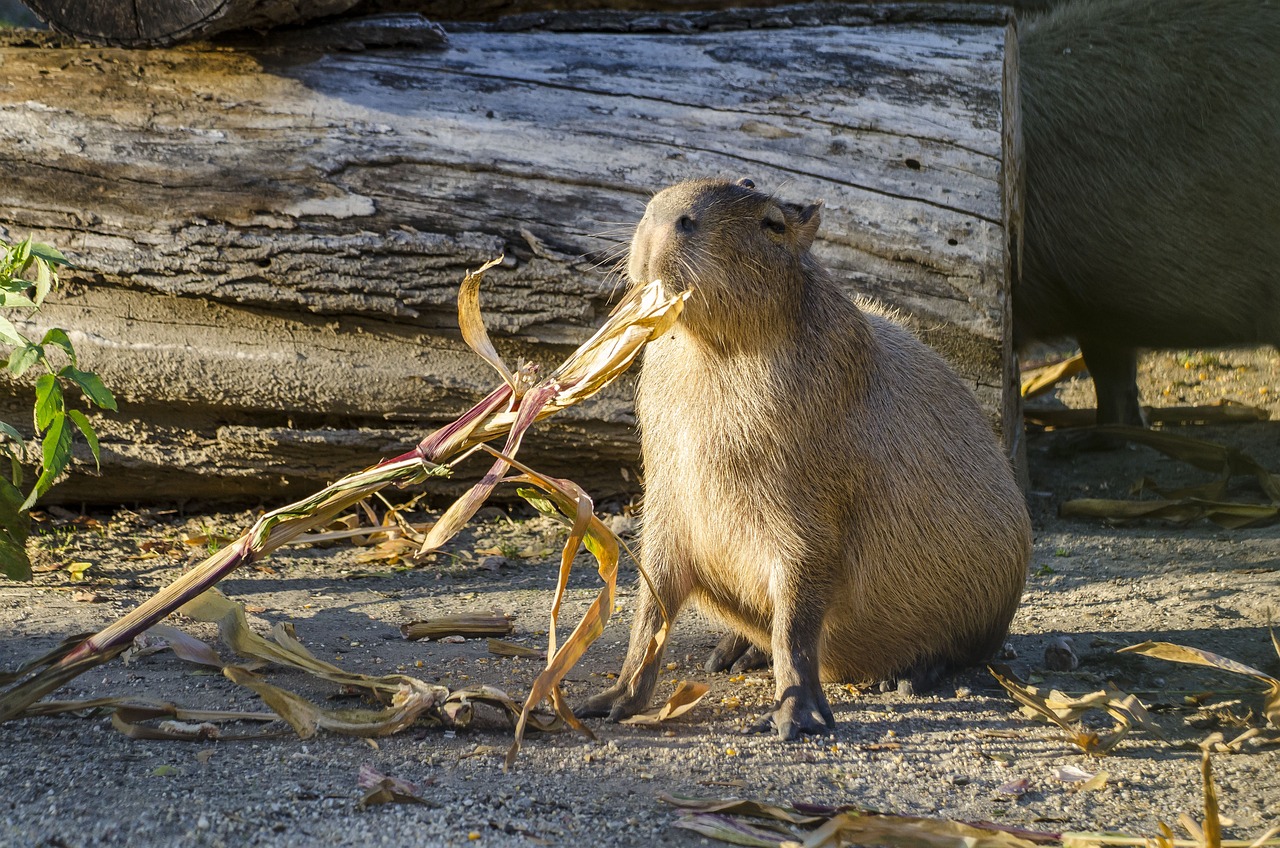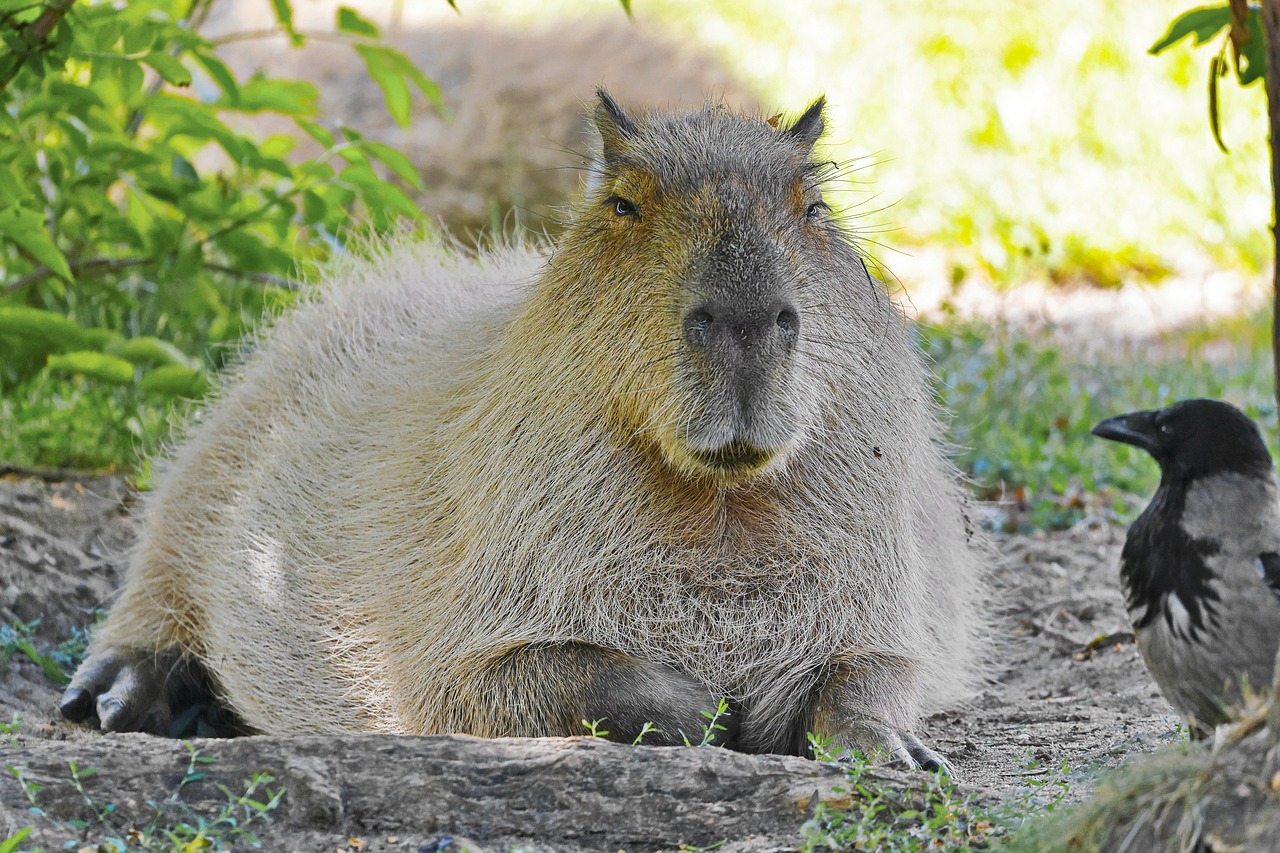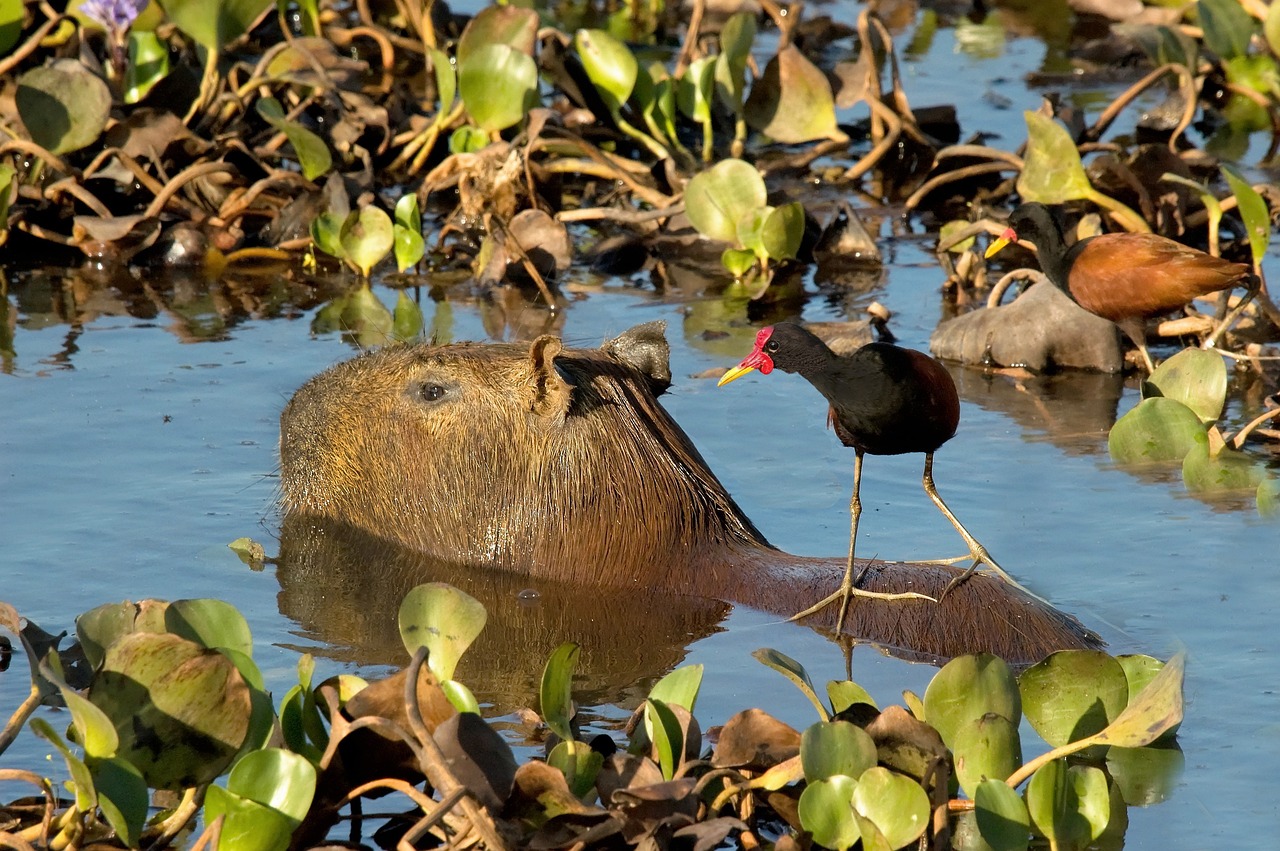
Embark on a journey into the enchanting realm of the facts of Capybara, a creature that redefines the typical image of rodents. In our exploration, we’ll delve into ten fascinating capybara facts that will astound you and expand your knowledge about what is a capybara.
What is a capybara?
Capybaras, recognized as the world’s largest rodent, exhibit a unique appearance akin to a guinea pig and beaver hybrid. With their stout, barrel-shaped bodies, short limbs, and small, rounded heads, they stand out in the animal kingdom. Their coarse, reddish-brown fur insulates them well within their habitats. A full-grown capybara can reach a size of 4 feet in length and weigh up to 150 pounds. Their eyes and ears are strategically positioned high on their heads, allowing them to stay alert even when partially submerged, a trait that answers the question of what a capybara looks like.
Masterfully adapted to a semi-aquatic lifestyle, capybaras are the epitome of a semi-aquatic rodent, with physical traits finely tuned to their environment. Their webbed toes act as natural paddles, enhancing their ability to swim gracefully and dive for extended periods. Known for their aquatic expertise, capybaras can remain submerged for up to five minutes, often seen floating in water with only their eyes and nostrils visible.
In addition to their swimming capabilities, capybaras possess robust, chisel-like incisors that continuously grow, an adaptation essential for their herbivorous diet. These powerful teeth are ideal for grinding a diet rich in grasses and aquatic plants. As mammals with a specialized digestive system, capybaras efficiently process nutrients from their plant-based diet, making them highly efficient herbivores.
Habitat and distribution of capybaras

Native to South America, capybaras are found in a variety of ecosystems across the continent. They are particularly prevalent in the tropical zones of countries like Brazil, Venezuela, Colombia, and Argentina. These semi-aquatic mammals are often found near freshwater sources such as rivers, lakes, and swamps, which are essential to their lifestyle and survival. Their reliance on water for hydration and thermoregulation is a key aspect of where do capybaras live.
Capybaras exhibit remarkable adaptability, thriving in a range of ecosystems from grasslands and savannas to wetlands and forests, as long as they have access to water and suitable vegetation. These adaptable creatures can withstand diverse climates, from intense heat to cooler temperatures, demonstrating their ecological resilience by maintaining access to essential water and food sources.
While capybaras are adaptable in their habitat preferences, they are primarily found in South America, where they play a crucial ecological role as ecosystem engineers. Their foraging habits help maintain plant life balance and promote habitat diversity, which in turn benefits numerous other species in the region. This underscores the significance of these South American rodents in their natural habitats.
Social behavior and communication of capybaras
Capybaras are known for their unique capybara social behavior, forming cohesive capybara groups that are often described as ‘bachelor herds.’ These herds, which can consist of up to 20 capybaras, typically follow the lead of a dominant male. The intricate social structure of these groups is instrumental in fostering strong bonds and cooperative behaviors among the capybara members.
An intriguing aspect of capybara social behavior is their grooming habits, which are characterized by intricate capybara grooming rituals. Capybaras engage in mutual grooming, meticulously cleaning each other’s fur and using their scent glands to mark fellow group members. This practice is not only crucial for parasite removal but also strengthens the social connections within the capybara herd.
The array of capybara vocalizations highlights their advanced capybara communication system. These vocalizations, including purrs, whistles, barks, and chirps, each serve distinct purposes within the herd. A sharp whistle, for example, may function as an alarm call, while other sounds are integral to maintaining the herd’s social cohesion and orchestrating group activities.
What do capybaras eat?
Despite their size, Capybaras are dedicated herbivores, maintaining a vegetarian diet that is predominantly composed of grasses and aquatic plants. Their evolutionary adaptations have endowed them with sizeable incisors and powerful jaws, making them highly efficient grazers within their ecosystem.
The capybara digestive system is specially adapted for their grazing lifestyle, enabling them to effectively extract nutrients from their plant-based diet. Their digestion involves a fermentation process, facilitated by a spacious cecum that houses beneficial bacteria and microorganisms adept at breaking down cellulose from plant fibers.
In addition to grasses, the capybara diet includes a variety of aquatic plants such as water hyacinths and water lettuce. Demonstrating their proficient swimming abilities, capybaras forage in water bodies, consuming the rich vegetation along the water’s edge, which is crucial for fulfilling their dietary requirements.
Reproduction and life cycle of capybaras

Capybaras exhibit a distinctive reproductive approach, with the dominant male capybara mating with multiple females from his harem throughout the rainy season. The role of this dominant male is crucial during the breeding period, as it ensures the propagation of the species within the capybara social group.
After a gestation period of about 150 days, the female capybara gives birth to a litter of capybara pups, usually numbering between four and eight. These capybara newborns are precocial, meaning they are relatively mature when born and can walk and swim soon after birth. During their early life stages, they rely on their mother’s milk for nourishment.
The mother capybara diligently protects her capybara offspring, providing them with milk and care for several months. As the capybara pups mature, they begin to eat solid food and eventually join the larger social group. They reach sexual maturity at around one year old and have a lifespan of 8-10 years in the wild, with some capybaras living longer in captivity.
Predators and threats to capybaras
Despite being the largest rodents on Earth, capybaras are vulnerable to the threats posed by the capybara’s natural predators. These semi-aquatic mammals are targeted by jaguars, pumas, and anacondas, among the most formidable predators in their South American habitats.
To survive, capybaras have developed various defense mechanisms against the dangers they encounter. Their sharp sense of hearing and strong sense of smell alert them to potential threats, while their impressive swimming abilities in aquatic environments serve as a refuge from predators.
Even with their self-defense skills, capybaras face challenges that impact their conservation status, such as habitat loss due to deforestation and human encroachment. This destruction of their habitats affects their food sources, social structures, and breeding patterns. Additionally, hunting for capybara meat and hide further threatens their population.
Cultural significance of capybaras
Capybaras hold profound cultural significance in the regions they populate. In parts of South America, capybara meat is a culinary treasure, celebrated for its tenderness and leanness, and is a key ingredient in many traditional dishes.
Conversely, in various cultural contexts, capybaras are revered as sacred animals and symbols of wealth, fertility, and good luck. Associated with water deities, they are believed to bring fortune to those they encounter. Some indigenous communities honor capybaras as sacred beings, protected by deep-rooted cultural beliefs and practices.
Capybaras, known for their status as exotic pets, have captured the interest of animal enthusiasts worldwide. Nevertheless, it’s imperative to understand that providing specialized care for a capybara requires a profound knowledge of their unique needs. When contemplating adding these exotic pets to your household, their well-being and the importance of conservation should be at the forefront of your decision.
Here are fun facts of capybaras
The world of capybaras is full of capybara surprises, and to pique your interest further, here are some fun facts about these fascinating creatures:
- Capybaras are excellent swimmers and can stay underwater for up to five minutes.
- Capybaras come equipped with scent glands located on their snouts, which play a pivotal role in territorial marking and serve as a communication tool among their kind.
- Capybaras are highly adaptable and can adjust their body temperature to suit their environment.
- A notable aspect of capybara behavior is their social grooming, where they often form grooming trains, with multiple capybaras partaking in sequential mutual grooming sessions.
- Renowned for their playful nature, capybaras are a joy to observe as they partake in games and lively chases, reflecting their jovial demeanor.
- In their natural habitat, capybaras have a capybara lifespan ranging from 8 to 10 years, but under human care, their longevity may increase to 12-15 years, with some surpassing this average.
- Capybaras are characterized by a low metabolic rate, which aids in energy conservation and is a key factor in their ability to thrive within their natural habitats.
- Despite their considerable stature, capybaras are skilled in the art of camouflage and adept at using their natural surroundings to conceal themselves from predators and onlookers alike.
- Embracing a semi-aquatic lifestyle, capybaras spend a significant portion of their time in aquatic environments, which not only aids in body temperature regulation but also provides a haven from potential threats.
- In certain regions of the world, capybaras have transitioned from wild creatures to domesticated capybaras, becoming cherished pets in homes or contributing to conservation efforts aimed at protecting their species.
Conclusion
Capybaras are truly extraordinary, captivating us with their distinctive traits and behaviors. Their impressive size, webbed feet, sociable nature, and herbivorous diet are just a few characteristics that amaze enthusiasts. This fascination goes beyond mere curiosity, highlighting the importance of preserving their natural habitats to ensure the survival and prosperity of these unique creatures.
Also, read Fun Facts About Red Pandas